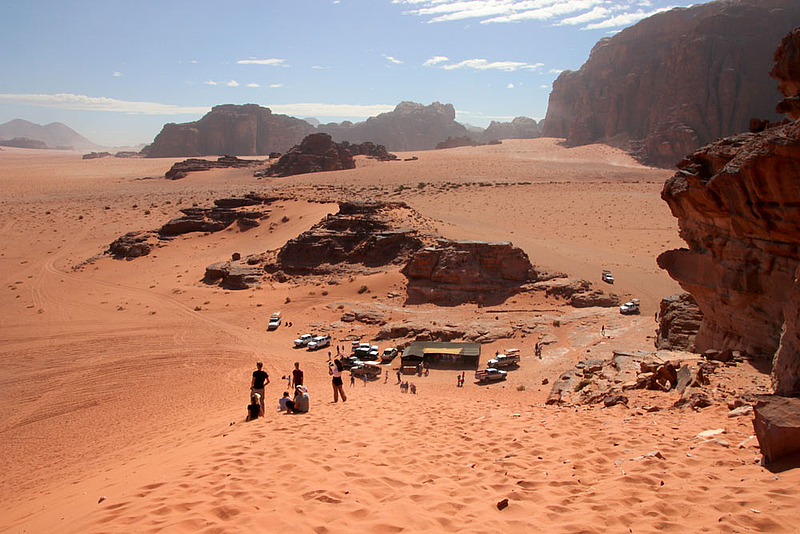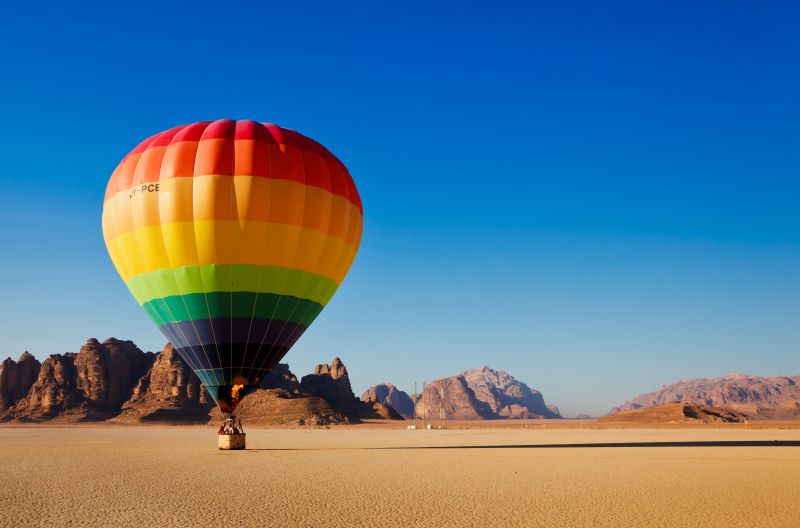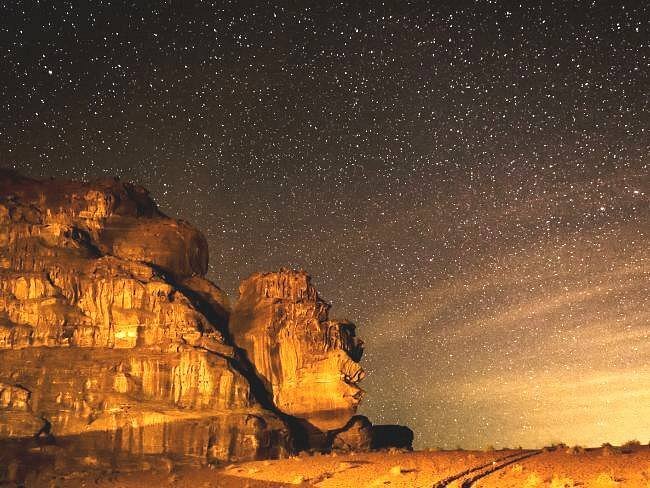Best Time to Visit Wadi Rum: Seasonal Guide

When to plan your trip for the optimal desert experience.
Timing your visit to Wadi Rum can significantly impact your experience in this magnificent desert landscape. The different seasons bring dramatic changes in temperature, tourist numbers, and even the quality of light for photography. This comprehensive guide will help you determine the best time to visit Wadi Rum based on your preferences and priorities.
Seasonal Overview
Spring (March to May)
Spring is widely considered the optimal time to visit Wadi Rum. The temperatures are pleasantly warm during the day (20-30°C/68-86°F) and comfortably cool at night (10-15°C/50-59°F). The desert occasionally blooms with wildflowers after winter rains, adding splashes of color to the red landscape. The clear skies and moderate temperatures make this an ideal season for hiking, rock climbing, and extended desert exploration.
Pros: Ideal temperatures, possible wildflower blooms, excellent visibility, perfect for outdoor activities
Cons: Peak tourist season (especially April), higher prices, need to book accommodations well in advance
Summer (June to August)
Summer brings intense heat to Wadi Rum, with daytime temperatures regularly exceeding 40°C (104°F). The desert floor becomes scorching hot, making midday activities uncomfortable or even dangerous. However, mornings and evenings can still be pleasant, and the nights cool down significantly, offering excellent stargazing opportunities. Summer also sees fewer tourists, meaning more solitude and potentially lower prices.
Pros: Fewer tourists, potential discounts, excellent night skies, warm evenings for comfortable stargazing
Cons: Extreme daytime heat, limited hiking opportunities, need for careful hydration and sun protection, activities restricted to early morning and late afternoon
Autumn (September to November)
Like spring, autumn offers moderate temperatures that are ideal for desert exploration. By late September, the summer heat begins to dissipate, creating comfortable conditions for all activities. The tourist crowds are generally smaller than in spring, especially in early autumn, while the weather conditions remain excellent. The light during autumn has a particular golden quality that photographers appreciate.
Pros: Pleasant temperatures, smaller crowds than spring, beautiful light for photography, good value
Cons: Increasing tourist numbers by November, occasional sandstorms possible
Winter (December to February)
Winter brings a dramatic transformation to Wadi Rum. Daytime temperatures are mild and comfortable (15-20°C/59-68°F), perfect for hiking and climbing. However, nights can be extremely cold, often dropping below freezing. Occasional rain showers occur, and while rare, even snow is possible on the higher mountains. The winter light creates striking contrasts on the rock formations, and the clear winter air offers exceptional visibility.
Pros: Comfortable daytime temperatures for activities, dramatic lighting, fewer tourists, lower prices
Cons: Very cold nights (often below freezing), potential for rain disrupting plans, shortened daylight hours, need for serious warm clothing
Month-by-Month Guide
January
Weather: Daytime 15-18°C (59-64°F), nighttime 2-5°C (36-41°F), occasional rain
Crowd level: Low
Recommendation: Good for budget travelers who don't mind cold nights. Bring serious warm clothing for evenings.
February
Weather: Daytime 17-20°C (63-68°F), nighttime 3-7°C (37-45°F), occasional rain
Crowd level: Low to moderate
Recommendation: A good off-season option with improving temperatures. Perfect for hiking and climbing.
March
Weather: Daytime 20-25°C (68-77°F), nighttime 8-12°C (46-54°F), occasional rain early in month
Crowd level: Moderate, increasing throughout month
Recommendation: Excellent month to visit before peak season crowds arrive. Possible wildflowers after winter rains.
April
Weather: Daytime 25-30°C (77-86°F), nighttime 10-15°C (50-59°F), generally dry
Crowd level: High (peak season)
Recommendation: Perfect weather but book well in advance. One of the most popular months.
May
Weather: Daytime 30-35°C (86-95°F), nighttime 15-18°C (59-64°F), dry
Crowd level: Moderate to high
Recommendation: Still excellent conditions but getting warmer. Good balance of weather and smaller crowds than April.
June
Weather: Daytime 35-40°C (95-104°F), nighttime 18-22°C (64-72°F), dry
Crowd level: Low to moderate
Recommendation: Beginning of hot season. Morning and evening activities only. Good for budget travelers.
July
Weather: Daytime 38-42°C (100-108°F), nighttime 20-24°C (68-75°F), dry
Crowd level: Low
Recommendation: Only for heat-tolerant travelers. Significant discounts available. Limit outdoor activities to early morning and late evening.
August
Weather: Daytime 38-42°C (100-108°F), nighttime 20-24°C (68-75°F), dry
Crowd level: Low
Recommendation: Similar to July. Extreme heat but good deals and few tourists. Excellent stargazing.
September
Weather: Daytime 33-38°C (91-100°F), nighttime 18-22°C (64-72°F), dry
Crowd level: Low to moderate
Recommendation: Improving conditions as month progresses. Good value before autumn rush.
October
Weather: Daytime 25-30°C (77-86°F), nighttime 12-16°C (54-61°F), generally dry
Crowd level: Moderate to high
Recommendation: Excellent month to visit with ideal temperatures and good light for photography.
November
Weather: Daytime 20-25°C (68-77°F), nighttime 8-12°C (46-54°F), occasional rain possible
Crowd level: Moderate
Recommendation: Very good conditions with fewer tourists than October. Bring layers for cold evenings.
December
Weather: Daytime 15-20°C (59-68°F), nighttime 3-7°C (37-45°F), occasional rain
Crowd level: Low, except holiday period
Recommendation: Good for budget travelers. Pleasant daytime temperatures but very cold nights. Christmas/New Year period sees spike in visitors.
Best Time for Specific Activities
Photography
For photographers, the quality of light is often more important than temperature. The "golden hours" around sunrise and sunset are magical in Wadi Rum year-round, but certain seasons offer distinct advantages:
- Spring and autumn: Offer the best combination of comfortable temperatures and beautiful light
- Winter: Provides dramatic low-angle light throughout the day, creating deeper shadows and more texture on the rock formations
- Summer: Harsh midday light but spectacular clear night skies for astrophotography
Hiking and Rock Climbing
These physically demanding activities are best enjoyed when temperatures are moderate:
- Best: March-May and October-November
- Good: December-February (daytime)
- Challenging: June and September (early morning only)
- Not recommended: July-August (except for very early morning)
Stargazing
Wadi Rum offers exceptional stargazing year-round due to its clear desert air and minimal light pollution, but certain factors affect the experience:
- Summer: Warmer nights make for comfortable extended stargazing, but shorter nights
- Winter: Longest nights and exceptionally clear air, but very cold temperatures
- Spring/Autumn: Good balance of comfortable temperatures and decent night length
Pro tip: Plan your visit around the new moon for the darkest skies and best stargazing conditions.
Camel Trekking
This traditional way to explore the desert is available year-round but is most enjoyable in moderate temperatures:
- Best: March-May and September-November
- Good: December-February
- Limited: June-August (early morning or late afternoon only)
Considerations for Your Visit
Budget
If you're traveling on a budget, consider visiting during the shoulder or off-seasons:
- Most expensive: April, October, and holiday periods (Christmas/New Year)
- Mid-range: March, May, September, November
- Best value: June-August, December-February (excluding holidays)
Crowds
The presence of other tourists can significantly impact your desert experience:
- Busiest: April, October, and holiday periods
- Moderate: March, May, September, November
- Quietest: June-August, December-February (excluding holidays)
Special Events and Festivals
Consider timing your visit to coincide with local cultural events:
- Aqaba Traditional Arts Festival: Usually held in February, featuring Bedouin music and crafts (in nearby Aqaba)
- Ramadan: The Islamic holy month (dates vary each year) brings a unique atmosphere but may limit some services
- Eid al-Fitr and Eid al-Adha: Islamic holidays that bring domestic tourism and celebrations
Combining Wadi Rum with Other Jordan Destinations
Most travelers visit Wadi Rum as part of a larger Jordan itinerary. Consider these seasonal factors when planning your broader trip:
Dead Sea
The Dead Sea can be unbearably hot in summer (40°C+/104°F+) but pleasant in winter (20-25°C/68-77°F). Spring and autumn offer the best conditions for combining these destinations.
Petra
Petra's temperatures are similar to Wadi Rum but slightly cooler due to higher elevation. The site involves considerable walking, making spring and autumn ideal. Winter can be cold and occasionally rainy, while summer is very hot for exploring this extensive site.
Aqaba
This coastal city is a popular addition to Wadi Rum itineraries. Summer is actually high season in Aqaba for beach and diving activities, as the Red Sea moderates temperatures. Winter offers pleasant temperatures for exploring but can be too cool for swimming.
Final Recommendations
If comfort is your priority:
Visit during April, May, October, or November when temperatures are most pleasant throughout the day and night.
If avoiding crowds is important:
Consider February, June, or September, which offer reasonable weather conditions with fewer tourists.
If you're on a tight budget:
July, August, and January offer the lowest prices, though with weather compromises (extreme heat or cold nights).
If photography is your focus:
Late October to early November offers beautiful light, comfortable temperatures, and relatively fewer tourists than peak season.
The overall best compromise:
Early to mid-May or late September to early October typically offer the best balance of good weather, reasonable crowds, and fair prices.
Regardless of when you choose to visit, Wadi Rum's timeless beauty transcends seasons. Each time of year offers its own unique perspective on this magnificent desert landscape, from the possible wildflowers of spring to the crystal-clear night skies of summer, the golden light of autumn, or the dramatic cloud formations of winter. With proper preparation for the conditions, any season can provide an unforgettable Wadi Rum experience.

